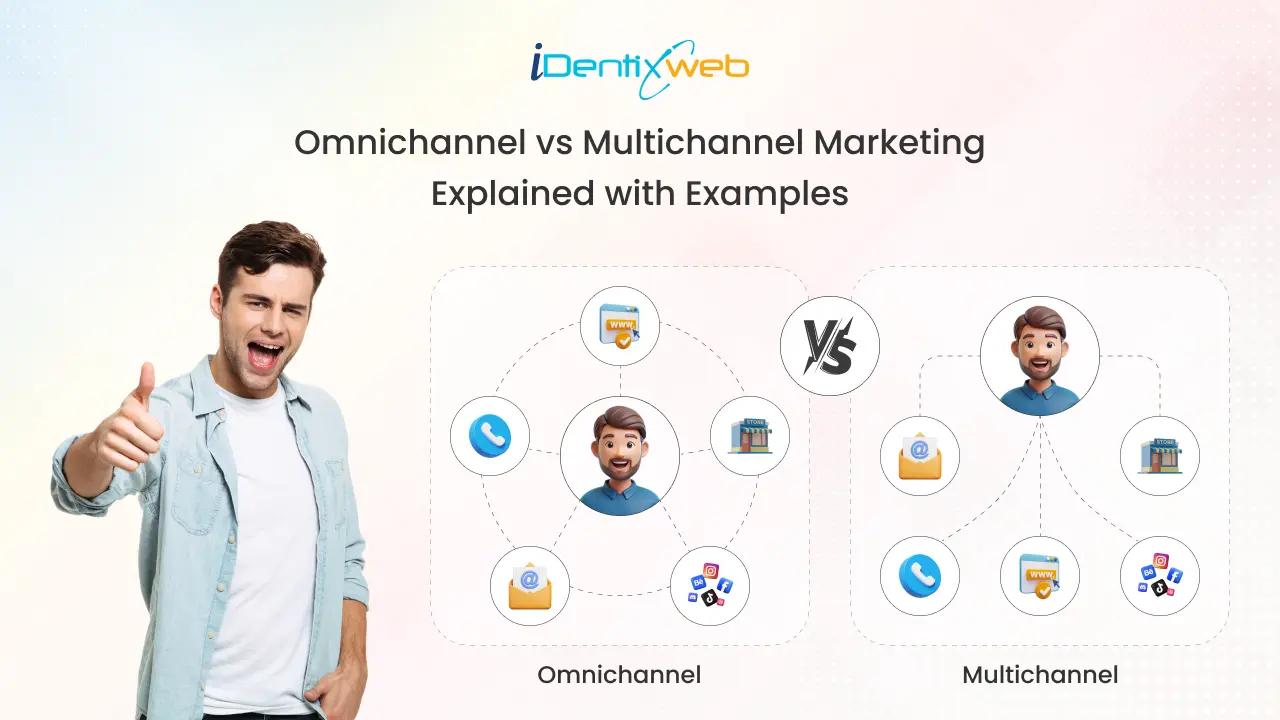
Are you confused by the terms omnichannel vs multichannel marketing? Don’t worry. Many marketers find it confusing.
While both strategies involve using multiple channels, however they differ in how they engage customers.
Customers now have many ways to engage with a brand. If you don’t rethink your marketing strategy, you risk losing them.
In this article, we will explain both of these marketing strategies so that you can decide which one to choose for your business.
Before we discuss omnichannel vs multichannel marketing in detail, first let’s explore multichannel marketing, its definition, benefits, and disadvantages.
Multichannel Marketing
Multichannel marketing uses various channels to reach customers. These channels include print media, websites, applications, email, social media and brick-and-mortar stores.
Each platform operates separately. This may cause customers to experience the brand differently depending on the platform. Multichannel marketing focuses on engaging customers. This is done by reaching them through their favoured channels.
Now let’s look at the pros and cons of multichannel marketing.
Pros
- Reaching customers where they are.
- Increasing customer engagement.
- Can start small by focusing on two channels.
Cons
- Tends to be more channel-centric. Customer experience may take a hit.
- Difficulty in tracking and measuring performance across multiple platforms.
- Might see a drop in customer satisfaction due to a lack of platform integration.
Now that we understand multichannel marketing, next let’s dive deeper into how omnichannel marketing takes customer experience to the next level.
Omnichannel Marketing
Omnichannel also involves multiple channels for sales and marketing. But unlike multichannel, all channels are integrated to provide a unified customer experience.
Integrating platforms helps you track marketing and sales performance.
Omnichannel marketing's main focus is customer experience. Omnichannel marketing is more advanced than multichannel. It starts with pre-purchase activities like ads and continues with post-purchase support.
Now let’s look at the pros and cons of omnichannel marketing.
Pros
- Offers a unified customer experience across touchpoints.
- Easier tracking of performance across platforms.
- Increases customer retention and loyalty.
Cons
- It requires a significant investment in technology, cost, and resources.
- Building an omnichannel marketing strategy takes time.
- Demands a well-coordinated tech stack and cross-team collaboration.
Here are some examples from leading brands to see omnichannel marketing in action.
Examples of Omnichannel Marketing
Nike
Nike’s omnichannel success includes innovative strategies. For example, Nike’s ‘Scan & try’ feature lets customers access key product info such as size, colors, price, and availability.
Nike also benefits from the strategy of picking up or returning products. This can be both from online or offline stores.
Their Nike Plus membership programs also help provide personalized recommendations and discounts. This makes the customer feel valued.
Nike’s seamless integration across platforms not only improves customer experience but also increases brand loyalty by allowing customers to check product availability in-store or online.
Next, let’s look at Netflix's omnichannel strategy.
Netflix
Netflix has taken hyper-personalization to the next level. Their omnichannel marketing includes providing content recommendations on desktop, tablet, and mobile devices.
It uses artificial intelligence to analyze real-time data and customer behaviour. This predicts what the customer might watch next. Their omnichannel approach syncs the “watching history” of the users across every device.
Next, let’s explore how Walmart applies omnichannel marketing.
Walmart
Walmart focuses on providing digital experiences by combining three things. Physical stores, home delivery, and pickup location services.
Their Buy Online & Pickup in Store (BOPIS) allows customers to buy online and pick up their items at the nearest Walmart store.
Walmart offers revolutionary Go-fencing technology. This links customers’ shopping accounts on their phone to Walmart’s physical store. It alerts the retailer when the customer arrives to pick up the order. This helps the company to provide a smooth shopping experience at scale.
Here are the key differences between omnichannel vs multichannel marketing to help you better understand.
| Omnichannel Marketing | Multichannel Marketing |
|---|---|
| One single view of the customer across channels. | Multiple views for different channels of the customer. |
| Seamless customer support. | Siloed customer support. |
| It is harder to implement. | It is easier to implement. |
| All channels work together to engage customers. | Customer interaction depends on each channel. |
| Focuses on customer experience. | Focuses on customer engagement. |
Now that you understand the basics, let’s explore how these marketing strategies are used in e-commerce.
Omnichannel vs Multichannel E-commerce
Here’s an example of how omnichannel e-commerce works in practice:
A customer browsing products on your website may add items to their cart. Imagine if the same customer could continue where they left off in your mobile app.
Omnichannel e-commerce marketing helps businesses understand customer behavior and their pain points. It achieves this by integrating customer data across all media.
On the other hand, multichannel e-commerce helps you to sell your products and services across multiple channels. The shopping experience may differ depending on the platform the customers use.
E-commerce merchants favour omnichannel marketing. Every online merchant targets repeat business. They can provide the customer with a seamless shopping experience by analyzing data. This increases the brand’s retention rate.
Customer service is a basic differentiating factor between omnichannel vs multichannel marketing; however, omnichannel excels in customer service. Let’s see why.
Omnichannel vs Multichannel Customer Service
Understanding the key differences in omnichannel vs multichannel marketing can help businesses improve customer service.
Omnichannel excels in customer service. Multichannel allows customers to interact with the brand through separate channels. Omnichannel combines customer data from all platforms to provide better customer support.
Let’s say a customer contacts your brand via chatbot and doesn't find it helpful. They can switch to a live agent without losing any chat history. This enhances customer satisfaction.
So if you want to provide better customer service, omnichannel marketing is your answer.
To wrap up, between omnichannel vs multichannel marketing, here’s how you decide which strategy fits best for your business.
Conclusion: What Should I Choose?
In conclusion, both strategies have benefits. Therefore, your choice of omnichannel vs multichannel marketing depends on how much interaction you want with your customers.
Multichannel marketing has a broader reach. It engages with customers on their chosen platforms. It’s great for branding and connecting with customers. It is also easier to apply than omnichannel.
Omnichannel marketing goes one step further. It integrates all marketing channels. Many top brands such as Nike, Walmart, and Netflix use an omnichannel marketing strategy to retain their customers.
Ready to upgrade your marketing strategy? Start with multichannel and upgrade to omnichannel as you grow your business.
FAQs
1. What is omnichannel marketing with an example?
Omnichannel marketing uses all channels to provide a unified customer experience. For example, Netflix recommends content across desktops, tablets, and mobile devices.
2. Why is omnichannel marketing important?
Omnichannel marketing provides a smooth customer experience. This helps in increasing customer satisfaction across multiple channels, leading to higher conversion rates and customer loyalty.
3. Is omnichannel marketing right for my business?
Yes. Omnichannel marketing is great for any business. But before implementing it, conduct research on your customers. Most importantly, which channels they use.
4. What is omnichannel vs multichannel marketing?
The main difference between omnichannel vs multichannel marketing strategies is that omnichannel is more customer-centric, while multichannel is more centred around the platform.
5. What is omnichannel in e-commerce?
Omnichannel marketing in e-commerce means using both online and offline marketing channels to provide the perfect shopping experience for your customers.
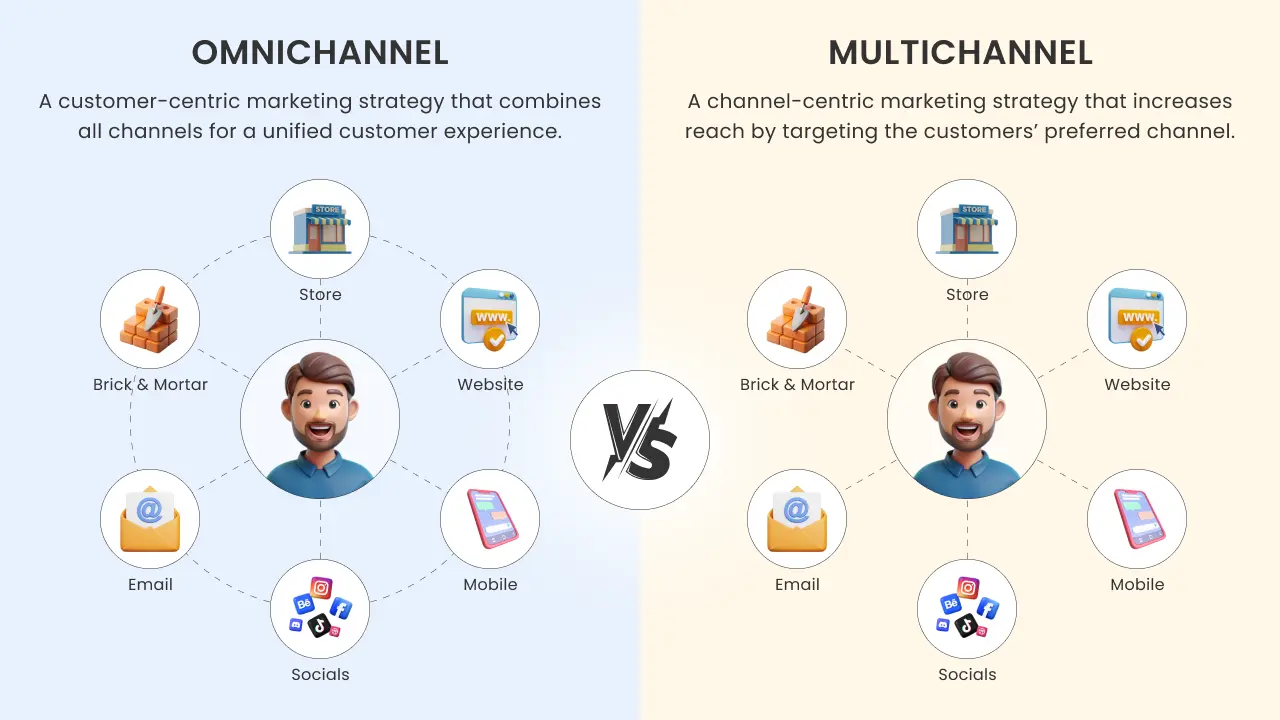
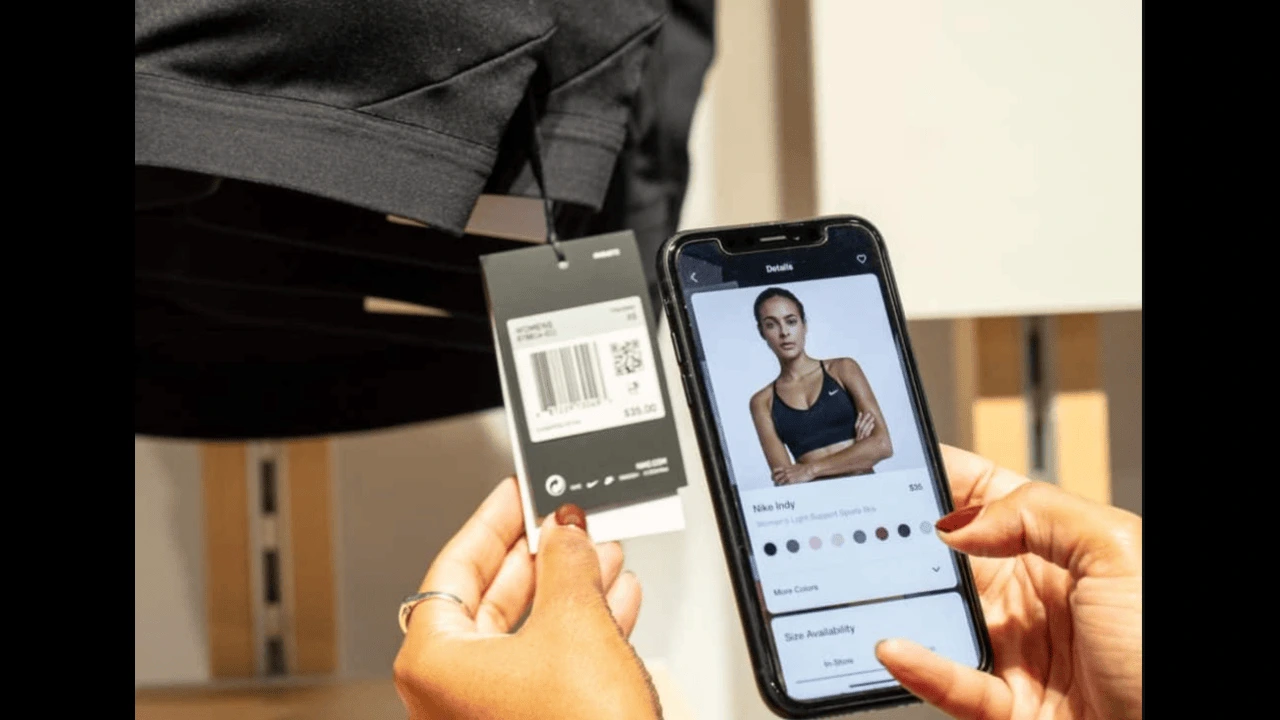
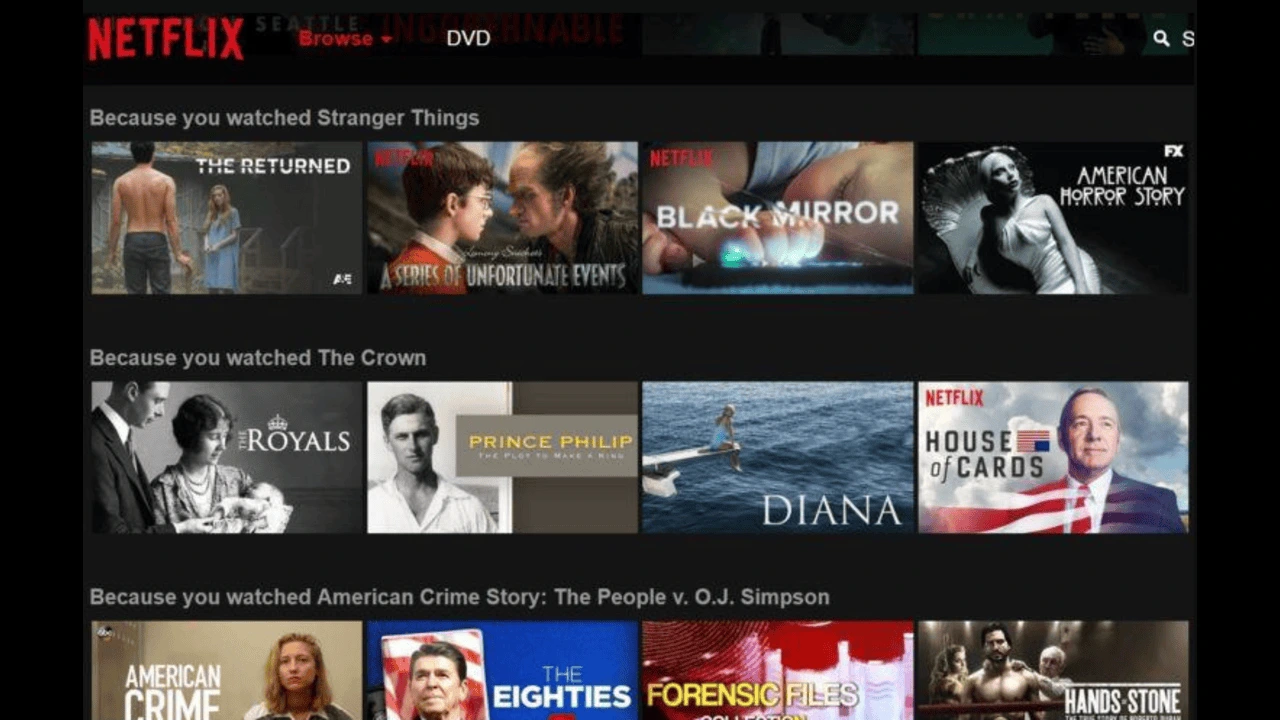





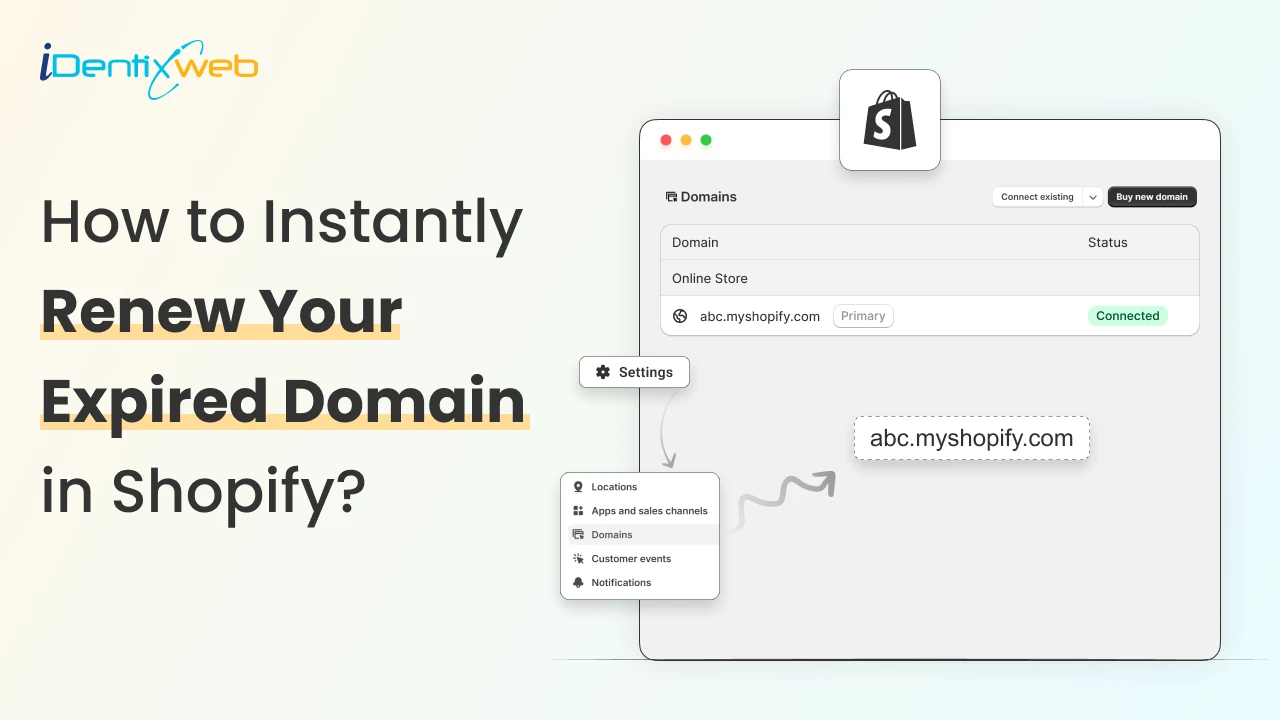

About the author
Vineet Nair
Vineet is an experienced content strategist with expertise in the ecommerce domain and a keen interest in Shopify. He aims to help Shopify merchants thrive in this competitive environment with technical solutions and thoughtfully structured content.